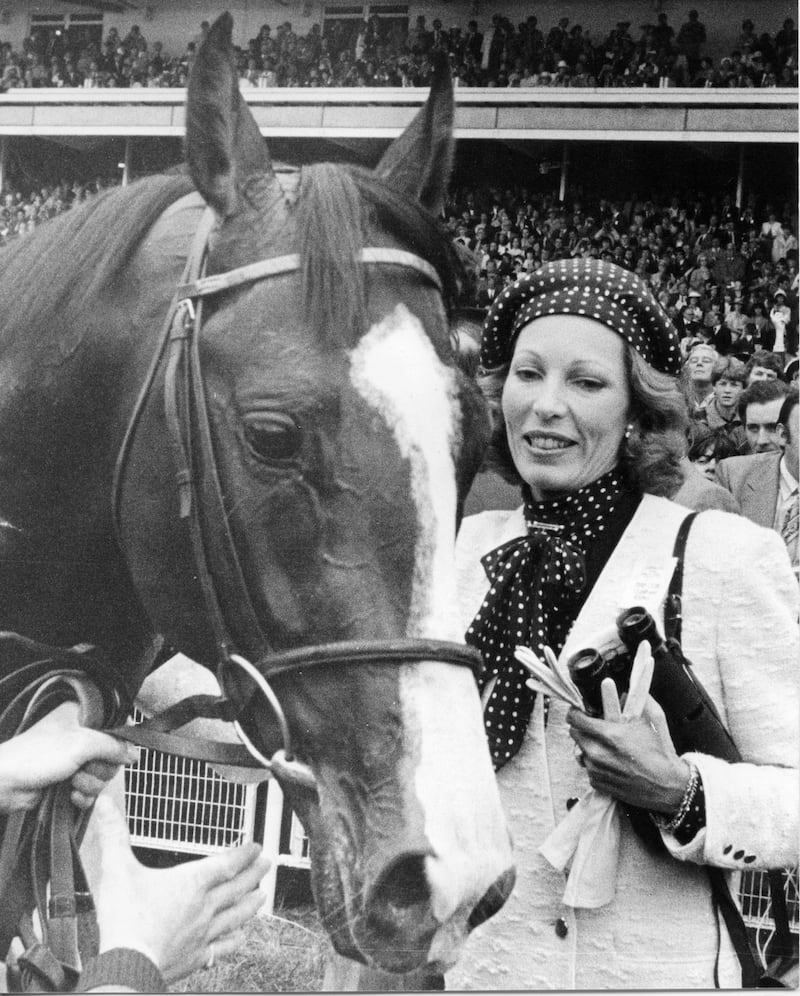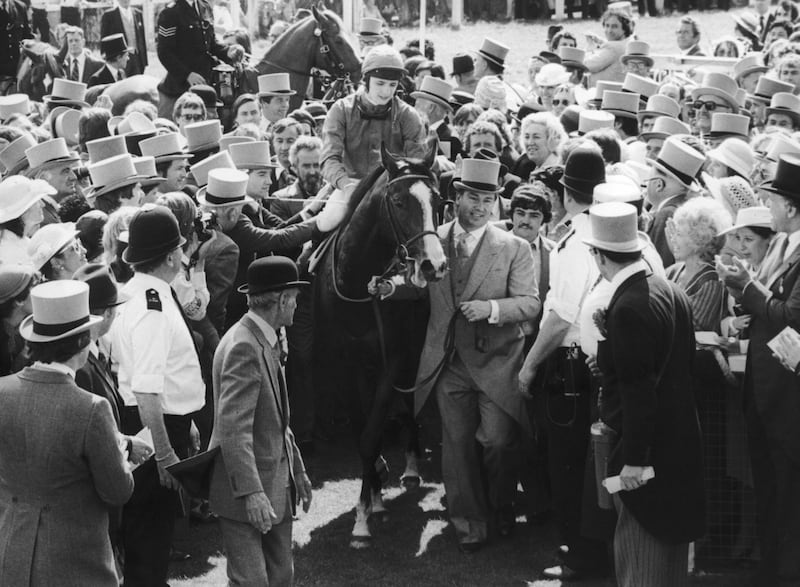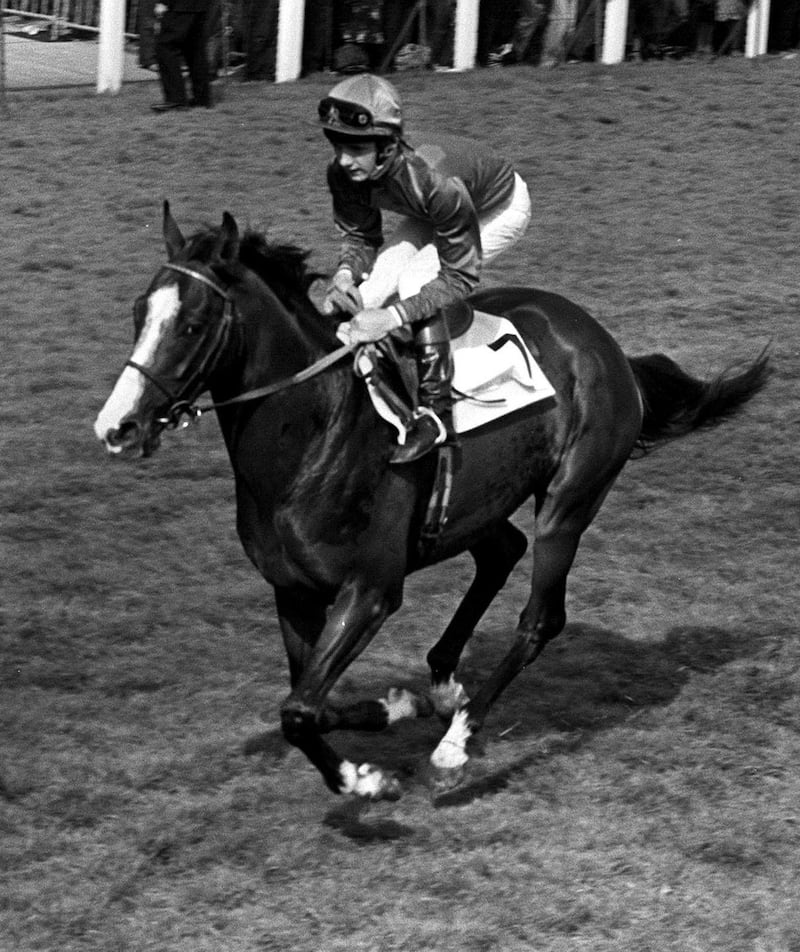Before becoming part of folklore, or reduced to a shabby punchline, Shergar was one of the finest racehorses of the last half-century.
A tragic mystery due to his kidnapping by the IRA in 1983, it can get overlooked how revulsion surrounding such a grotesque act was bound up in the impact the colt made on the wider public consciousness doing what he was bred to do.
Saturday's 242nd Epsom Derby is the 40th anniversary of Shergar turning racing's Blue Riband into an unparalleled rout.
Under his 19-year-old Irish jockey, Walter Swinburn, the scampering odds-on favourite with the big white face won pulling up by 10 lengths in scorching summer sunshine.
It's still the widest winning margin in Derby history. John Matthias, the jockey on runner-up Glint Of Gold, briefly thought he'd won because Shergar was so far ahead.
Epsom, renowned as the ultimate test of a thoroughbred, has never seen a horse so flamboyantly live up to his reputation for winning by distance.
In an era dominated by Lester Piggott’s instinct for winning by no more than necessary, Shergar’s run style was a swashbuckling aberration.
Piggott had ridden the son of Great Nephew in his two starts as a two-year-old, the first a debut win at Newbury followed by a narrow defeat in the Group One Doncaster Futurity.
But by 1981 trainer Michael Stoute had Swinburn as his stable jockey. Eager to make an impression the teenager wasn't playing around when Shergar made his three-year-old debut at Sandown.
The new partnership swept clear to win by 10 lengths. Shortly afterwards, and upped to a mile-and-a-half for the first time, Shergar won the Chester Vase by a dozen lengths.
These were distances more akin to American dirt rather than European turf. Even the most untrained eye could appreciate such obvious superiority.
At Epsom, Shergar faced 17 opponents. Piggott, famously the “housewives choice” was second favourite on the 7-1 shot Shotgun. As it transpired there was barely any kind of second.
The Irish-bred star tracked the pace, eased around Tattenham Corner and shot clear. Eager to make no mistakes, Swinburn pushed out until inside the final furlong before stealing a glance behind. If he could barely believe how far clear he was then he wasn’t alone.
"The Derby is a procession!" exclaimed BBC commentator Peter Bromley. "There's only one horse in it. You need a telescope to see the rest!"

The stunning visual impact meant Shergar became much more than a racing story. His arrival at Dublin Airport for the Irish Derby three weeks later made the RTÉ news.
With Swinburn suspended, Piggott was back on board and barely had to move as Shergar won the Curragh classic just a few hundred yards from where he would subsequently be kidnapped at Ballymany Stud.
The four-length runner-up was Cut Above, but barely anyone noticed him.
A month later Piggott again played a role in Ascot’s King George when Shergar took on older horses for the first time.
Far from holding a grudge the most famously ruthless of riders allowed Swinburn a dream run up his inner into the straight which Shergar eventually turned into another four-length victory.
He was, indisputably, the best mile-and-a-half horse in Europe at that point.
Pointed to the Prix de l'Arc de Triomphe in October his owner, the Aga Khan, opted to prep him in the world's oldest classic, the St Leger, over an extended mile-and-three-quarters.
Even at the time it was an unusual step. Today it looks almost quaint. Speed is the currency for a stallion career, not stamina. Ultimately, it didn’t work but it wouldn’t have at any distance.
Shergar in September was a shadow of his summer self. He struggled home fourth behind Cut Above, the horse he’d dismissively swatted aside at the Curragh. His racing career was over.
However, those crucial wide-margin victories helped him to be rated among the great names of modern racing.
A classification system introduced in 1977 ranks Shergar joint fourth-highest rated horse in the last 44 years by European racing’s official handicappers.

An academic handicap containing the very best would see Frankel top on a mark of 140lbs or 10st. He is followed by the 1986 champion Dancing Brave on 138, the 1997 Arc winner Peintre Celebre (137) and then Shergar, equal to Sea The Stars and the 1991 Derby winner Generous.
The Timeform organisation, whose categorisation goes back to 1948, rate only seven horses Shergar's superior. Legendary names such as Nijinsky and Sir Ivor are judged his inferior.
Such calculations are hardly conclusive evidence of merit. Peintre Celebre’s official rating is based on a single outstanding performance rather than sustained excellence and the task of pinning cold statistics on to flesh and blood performances is a difficult task in interpretation.
However, horses that translate their superiority into big margins are much more straightforward to estimate. If 2lbs equates to a length, then Shergar, like Frankel, was guaranteed to get figures fizzing.
“It’s well renowned, and maybe it’s a flaw in the system, that long-distance winners get full credit for that and Shergar illustrated what he had, a bit like Frankel,” says Ireland’s senior flat handicapper, Garry O’Gorman.
“The perfect contrast would be Sea The Stars who got the same 136 rating. His style in doing no more than necessary meant he won six Group One’s in six months and he didn’t leave it all on the dance floor.
“None of the horses that were third, fourth and fifth to Shergar at Epsom ever won at the Derby trip or won a Group One over any distance.
“Glint Of Gold was decent enough and Kalaglow [won the 1982 King George] ran in the race. He [Shergar] beat Cut Above at the Curragh but didn’t beat horses as good as, say, El Gran Senor did in the 2000 Guineas.
“But that rating is exceptional even at a remove of 40 years. He was a standout three-year-old, probably in an average year, and got rated very high because of the extreme winning distances,” he adds.

Like most “Goat” [greatest of all time] debates there is no way of knowing for sure who the very best was if they all lined up at their very best in some mythical race in the sky.
Shergar wouldn't have been sighted in a Guineas but Frankel never ran at a mile-and-a-half. Brigadier Gerard did and was treading water at the end of it. In 2009 Sea The Stars won everything at every distance in all conditions but never put up an individual number to rival Frankel's.
What’s indisputable though is Shergar’s right to be in any such conversation.
What he didn’t do shouldn’t overshadow what he did. And for a brief but glorious spell 40 years ago it’s hard to imagine him being bested at a mile-and-a-half.
It only serves to make the ultimate fate of such a rare and supreme athlete all the more gruesome.












